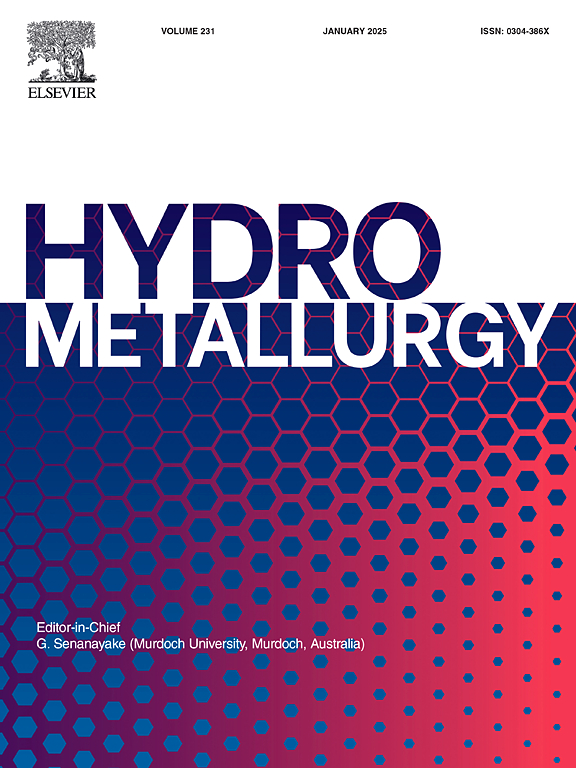Extraction of Au(I) from a thiosulfate leach liquor using guanidinium ionic liquid (C8)2dmg+Br− in 20 % (v/v) n-octanol/n-heptane diluent and stripping with aqueous NaCl
IF 4.8
2区 材料科学
Q1 METALLURGY & METALLURGICAL ENGINEERING
引用次数: 0
Abstract
In this study, novel guanidinium ionic liquids (GILs) were designed to achieve efficient extraction of Au(I) from thiosulfate solution. A series of process parameters affecting extraction efficiency, including reaction time, phase ratio, different types of guanidinium ionic liquids and their concentrations, as well as different stripping agents, were tested. The results showed that 2,2-dioctyl-1,1,3,3-tetramethylguanidinium bromide (C8)2dmg+Br−) dissolved in 20 % (v/v) n-octanol/n-heptane diluent exhibited excellent extraction performance for Au(I) under optimal extraction conditions. The extraction efficiency of Au(I) in thiosulfate solution was over 98.7 % at aqueous/organic phase volume ratio (RA/O) of 2. By combining Fourier Transform Infrared Spectroscopy (FTIR) and X-ray photoelectron spectroscopy (XPS), it was established that the extraction of Au(I) followed the mechanism of anion exchange and electrostatic attraction. The extraction efficiency of Au(I) by (C8)2dmg+Br− was substantially superior to Cu(II), Ni(II), Mn(II), Fe(III) and Co(III) in the thiosulfate leach liquor, showing remarkable selectivity for Au(I). In addition, gold in the loaded GIL phase can be efficiently stripped by NaCl solution. The newly developed extraction system had excellent recycling performance and environmental friendliness, which still maintained high gold extraction efficiency after five extraction/stripping cycles. These results confirmed that the GIL-based extraction system provides a feasible method for green and efficient gold extraction from thiosulfate solution and has a good application prospect.
用胍离子液体(C8)2dmg+Br -在20% (v/v)正辛醇/正庚烷稀释液中萃取硫代硫酸盐浸出液中的金(I)
本研究设计了一种新型胍离子液体(GILs),用于从硫代硫酸盐溶液中高效提取金(I)。考察了反应时间、相比、不同类型胍离子液体及其浓度、不同溶出剂等工艺参数对萃取效率的影响。结果表明,在最佳萃取条件下,2,2-二辛基-1,1,3,3-四甲基溴化胍(C8)2dmg+Br−)在20% (v/v)正辛醇/正庚烷稀释液中对Au(I)的萃取性能良好。在水/有机相体积比(RA/O)为2时,硫代硫酸盐溶液中Au(I)的萃取率可达98.7%以上。通过傅里叶变换红外光谱(FTIR)和x射线光电子能谱(XPS)相结合,确定了Au(I)的提取遵循阴离子交换和静电吸引的机制。在硫代硫酸盐浸出液中,(C8)2dmg+Br−对Au(I)的萃取效率明显优于Cu(II)、Ni(II)、Mn(II)、Fe(III)和Co(III),对Au(I)具有显著的选择性。此外,NaCl溶液可以有效地剥离负载GIL相中的金。该萃取系统具有良好的循环利用性能和环境友好性,在5次萃取/汽提循环后仍能保持较高的金萃取效率。结果表明,基于吉尔的萃取体系为绿色高效地提取硫代硫酸盐溶液中的金提供了一种可行的方法,具有良好的应用前景。
本文章由计算机程序翻译,如有差异,请以英文原文为准。
求助全文
约1分钟内获得全文
求助全文
来源期刊

Hydrometallurgy
工程技术-冶金工程
CiteScore
9.50
自引率
6.40%
发文量
144
审稿时长
3.4 months
期刊介绍:
Hydrometallurgy aims to compile studies on novel processes, process design, chemistry, modelling, control, economics and interfaces between unit operations, and to provide a forum for discussions on case histories and operational difficulties.
Topics covered include: leaching of metal values by chemical reagents or bacterial action at ambient or elevated pressures and temperatures; separation of solids from leach liquors; removal of impurities and recovery of metal values by precipitation, ion exchange, solvent extraction, gaseous reduction, cementation, electro-winning and electro-refining; pre-treatment of ores by roasting or chemical treatments such as halogenation or reduction; recycling of reagents and treatment of effluents.
 求助内容:
求助内容: 应助结果提醒方式:
应助结果提醒方式:


